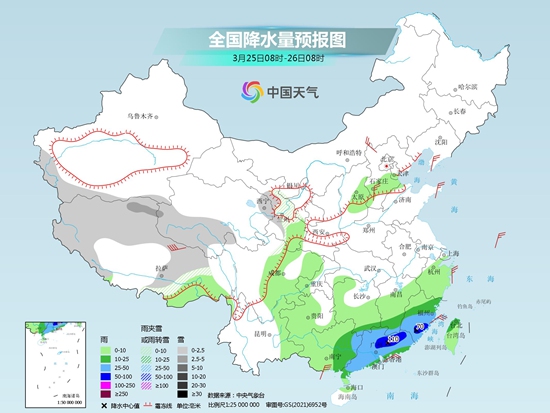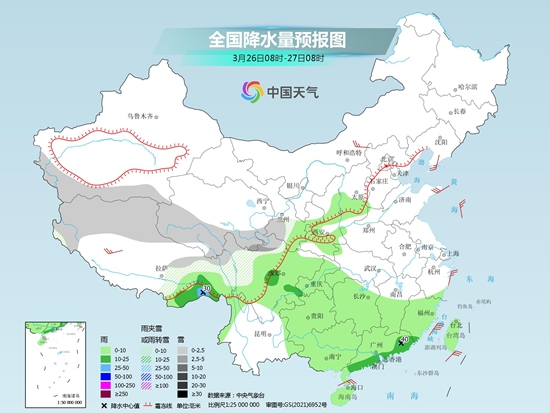Cctv newsAccording to the news of China Weather Network, today (March 25th), the heavy rainfall areas in the south of the Yangtze River and South China will be pressed to the south, and the heavy rain will be mainly concentrated in Guangxi, Guangdong and Fujian, and the local area will still be accompanied by strong convective weather. In terms of temperature, this Sunday, the north will gradually enter the warming mode; However, due to the continuous rainy weather in South China, the temperature will be suppressed until the end of March.
Heavy rainfall in South China continues to exert its strength. Guangdong, Fujian and other places need to be alert to secondary disasters.
Yesterday, heavy rainfall continued in Jiangnan and South China, and the local area was still accompanied by strong convective weather. Monitoring shows that from 08: 00 on the 24th to 06: 00 on the 25th, heavy rains fell in parts of southeastern Hunan, southwestern Jiangxi, southern Fujian, north-central Guangdong and northeastern Guangxi, and heavy rains occurred in Ganzhou, Jiangxi, Longyan, Fujian and Shaoguan, Guangdong.
Today, the heavy rainfall area will be pressed to the south, and the heavy rain will be mainly concentrated in Guangdong, southern Fujian and eastern Guangxi. From tomorrow, the precipitation in the south will be weakened, especially in the south of the Yangtze River and east of South China.
The Central Meteorological Observatory predicts that today, there will be light snow or sleet in parts of southern Xinjiang basin, northern and eastern Tibet, eastern Qinghai and central Gansu, and there will be medium snow in the local area. There are moderate to heavy rains in parts of southern Jiangnan and central and eastern South China, among which there are heavy rains or heavy rains in parts of southeastern Fujian and northern Guangdong.

Tomorrow, there will be light snow or sleet in parts of southern Xinjiang basin, northern and eastern Tibet, southern Qinghai, southern Gansu and northern Sichuan Plateau, and there will be medium snow in the local area. Some areas in southeastern Tibet, eastern Northwest China, southwestern Shanxi, eastern Southwest China, south-central Jiangnan, southern China, Taiwan Province Island and Hainan Island have moderate to moderate rain and local heavy rain.

Generally speaking, some areas in Guangdong, Jiangxi, Fujian and other places will be hit by continuous heavy rainfall, and the accumulated rainfall is large, and the rain is urgent. Attention should be paid to preventing secondary disasters such as geology and mountain torrents that may be induced by rainfall. However, the recent rainfall is beneficial to alleviate the meteorological drought in South China. After this round of heavy rainfall, Guangdong may meet the flood season standards and start the first flood season in South China.
The rainy weather in the south is frequently suppressed and warmed up, and the north is gradually warming up.
Under the combined influence of cold air and rainy weather, the temperature in South China will continue to drop today. The cumulative cooling in Guangxi and Guangdong will exceed 10℃, and the highest temperature today will mostly drop to around 20℃. Moreover, due to the frequent subsequent rainfall, the temperature in South China will not improve much until the end of March.
This Sunday, the temperature in most parts of the north will rise one after another, and the highest temperature on Sunday will generally return to a higher level than normal, and the warmer range will continue to increase at the beginning of next week. From the 27th, the highest temperature in most parts of Northeast China will return to above 15℃, and the cumulative temperature rise will generally exceed 10℃. The highest temperatures in North China and Huanghuai will gradually rise above 20℃, and the warmth will return.
In big cities, the highest temperature in Shenyang was only about 9℃ yesterday, and then the temperature will rise all the way, reaching 18℃ on the 28th and 20℃ on the 30th, or it will set a new high this year.
However, it should be noted that most of the north is still in the alternating period of winter and spring, and the temperature rises rapidly during the day, and it is still cold in the morning and evening, and the temperature difference will also widen. Around the 27th, the temperature difference between day and night in many places in the north will exceed 15℃, and even reach above 20℃ locally, reminding the public to pay attention to adding clothes to keep warm and avoid catching a cold.
关于作者